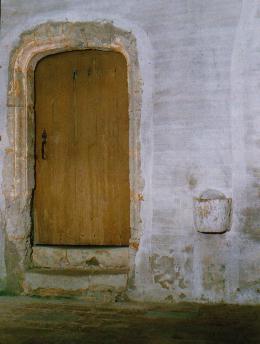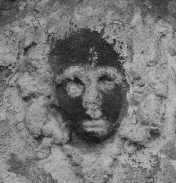From about a thousand years after Christ there dwelt a large community of people all over France who were so wretched that their lives could be compared to nothing less than the untouchables of India. Pilloried, ostracised, punished mercilessly on the slightest pretext, they were said to be of Satanic origin. Kinder people said that they were remnants of Arab folk who had fought for Charlemagne, and fled into France after his defeat at Roncesvalles. Others claimed that they were nothing more than Goth dogs remaining in the country after the expulsion of Visigoths by Clovis in the sixth century. Some of this persecuted tribe claimed to be descendants of the Cathars who had been exterminated in the Albigensian crusades of the 13th century. They were said to be leprous folk; they were thought to bleed from the navel on Good Friday; they were accused of having bright blue or olive eyes and yellowish skin and webbed fingers. They were called cagots, and they were at the bottom of the social pyramid in medieval France.
 In every way, their lot was singularly miserable. Although they were allowed to be Christians, they could only enter churches though a door on the left side of the porch [see picture on the left of the Cagot entrance to a church in a parish at Mus], and were banished to sit at the cold northern wall. Their men were only allowed to practise carpentry and rope-making; the women became midwives. They couldn't drink from town fountains, and could not walk barefoot. At communion, they received the host at the end of a stick. They paid no tax because their money was considered unclean. They were not to touch the parapets of a bridge with their bare hands. Every nation in France spat upon them: the Basques, the Béarnais, the Gascons and the Angevins, the Bretons. For about 900 years, for no reason other than their parents were cagots, children born into these families faced the same senseless oppression.
In every way, their lot was singularly miserable. Although they were allowed to be Christians, they could only enter churches though a door on the left side of the porch [see picture on the left of the Cagot entrance to a church in a parish at Mus], and were banished to sit at the cold northern wall. Their men were only allowed to practise carpentry and rope-making; the women became midwives. They couldn't drink from town fountains, and could not walk barefoot. At communion, they received the host at the end of a stick. They paid no tax because their money was considered unclean. They were not to touch the parapets of a bridge with their bare hands. Every nation in France spat upon them: the Basques, the Béarnais, the Gascons and the Angevins, the Bretons. For about 900 years, for no reason other than their parents were cagots, children born into these families faced the same senseless oppression.
Although legislation was passed sporadically to ameliorate their lot, prejudices continued to linger almost to the end of the 20th century. The country changed from Catholic to Protestant to Catholic, and the shameful side-doors in the churches remained. In medieval times, many priests refused to bury them with other Christians. In the late 1700s, a wealthy cagot, seen taking water from a fountain meant for the 'clean' people had his hand chopped off; it was then nailed to the church door. Cagots were forced to wear red webbed-foot symbols on their persons. Cagots were ordered to make their presence known in towns they entered by shaking a rattle. In 1741, a cagot with the temerity to till the land had his feet impaled with a hot iron. Even as late as 1964, there were families in the Pyrenean foothills mocked for being descendants on cagots. Indeed, a recent piece in the Independent 1 recounts the story of a woman who lives in the Pyrenees and claims to be a cagot. She is reluctant to have her children's photos published. "I'm sorry but no. It is OK for me to admit where I come from. But if people knew about my children's background, it might be difficult for them."
 Only traces remain of their presence in the country. Stone faces appear on door lintels and tiny doors in about sixty churches across France. Some place names preserve their existence: Cagoteries, or ghettoes (usually on the malarial side of rivers) where they dwelt can still be found in Pyrenean towns such as Hagetmau. Indeed, in Hagetmau, much of the citizenry to this day is involved in the chair-making industry, surely a result of the large cagot guilds of carpenters who lived and worked in the area. [The picture to the right is from a house (which was demolished in 2004) in the Quartier des Cagots in Hagetmau.]
Only traces remain of their presence in the country. Stone faces appear on door lintels and tiny doors in about sixty churches across France. Some place names preserve their existence: Cagoteries, or ghettoes (usually on the malarial side of rivers) where they dwelt can still be found in Pyrenean towns such as Hagetmau. Indeed, in Hagetmau, much of the citizenry to this day is involved in the chair-making industry, surely a result of the large cagot guilds of carpenters who lived and worked in the area. [The picture to the right is from a house (which was demolished in 2004) in the Quartier des Cagots in Hagetmau.]
Heartbreaking songs were written by the cagots, limning the ironic causes for their persecution. A Basque shepherdess in love with a cagot is moved to another pasture when her father is told that she wants to marry an untouchable. She sings: 2
The agot, they say, is the handsomest of men
Fair hair, white skin and eyes of blue.
You are the handsomest shepherd I know;
In order to be handsome, must one be an agot?
By this can you recognise an agot:
First look for clues in the ear;
He has one ear too large, and the other
Is round and covered all over with hair.
If that is so, you are not one of those folk,
For your ears are a perfect match.
If agots have always one ear too small,
I'll tell my father that yours are both alike.
There's no explanation for this irrational hatred, at least none that can be found in historical documents. As far as anyone could tell, they were indistinguishable from the rest of the population. They spoke the same language as their neighbours. About the only thesis that appears to make sense is that, similar to the equally reviled Gypsies, they had established a semi-nomadic existence, with rare skills and abilities that made them objects of envy and fascination. After eight centuries of persecution, they tended to be more skilful and resourceful than the surrounding populations, and more likely to emigrate to America 3. They were feared because they were persecuted, and because they might therefore seek revenge.
References
- The Last Untouchable in Europe, The Independent, July 28, 2008.
- Graham Robb, The Discovery of France, Picador, 2007, page 47.
- ibid., page 45

4 comments:
Very sad - we humans have this innate propensity to laugh at what appears to be different. These people must have been differentiable in appearance and as they were also by and large poor, they seem to have become objects of scorn and ostracization. In India of course this behavior was sanctified.
Asking out of curiosity, any idea if anybody has done a haplogroup study of cagotes? IF they have been socially isolated for centuries, some conclusions to their origins maybe possible.
Guru: by all accounts, there were no real distinguishing marks between the cagots and the general population, although myths about them were propagated, as I mentioned in the essay (eye colour and so on). In general, you were a cagot if your parents were cagots.
Arby K: You may find the discussion at this site pertinent to your question. As far as I can tell, there appear to have been no studies done on this matter (but see the last couple of paragraphs of the article.)
Thanks for the link. The reference of Arian Visigoths who held out against Reccared changed Spain frm Arianism to Catholicism is interesting. As per wiki, he faced a revolt in Septimania by Arians. They lost, but may have taken refuge in Gascony or nearby places.
The Arian connection can be seen as "Satanic origin" by Vaticans as well.
Post a Comment